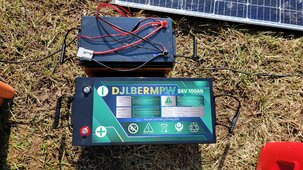AlpineJoe
New Member
- Joined
- Jun 13, 2022
- Messages
- 210
TLDR: Should I get a 24V premade LFP now (in the 100-300AH range) or wait for the prices to fall?
Background:
Pretty happy with my solar setup. Have ~ 4 KW of panels in various series/parallel arrangement going into 3 MPPT SCCs and then into a 24V LFP pack made from used CALB 180AH cells and 4 qty Redodo 12V 100AH batteries. I'm not sure the AH capacity remaining in CALB cells. What I do know is reading the graph from my Victron Smart Shunt, my voltage curve starts dropping steeply after~ 300AH of power is drawn during the night. This is with only a 30A draw. Voltage is down in the 25.7V range. I am able to charge the batteries back up to 100% during the day. I'd like to add more battery capacity to capture all that I'm making during the day, especially since I'm already seeing increased solar production from the sun angle changing as the days get longer (my panels are flat mounted). It's really noticeable on the weekend when I can leave my EV plugged in during the day to capture the excess. During the week, I don't have that luxury as my car is parked at work.
I read that LFP prices are supposed to drop, but I'm not seeing it in the packaged batteries. Is it going to trickle down into the pre-built batteries soon?
Thanks

Background:
Pretty happy with my solar setup. Have ~ 4 KW of panels in various series/parallel arrangement going into 3 MPPT SCCs and then into a 24V LFP pack made from used CALB 180AH cells and 4 qty Redodo 12V 100AH batteries. I'm not sure the AH capacity remaining in CALB cells. What I do know is reading the graph from my Victron Smart Shunt, my voltage curve starts dropping steeply after~ 300AH of power is drawn during the night. This is with only a 30A draw. Voltage is down in the 25.7V range. I am able to charge the batteries back up to 100% during the day. I'd like to add more battery capacity to capture all that I'm making during the day, especially since I'm already seeing increased solar production from the sun angle changing as the days get longer (my panels are flat mounted). It's really noticeable on the weekend when I can leave my EV plugged in during the day to capture the excess. During the week, I don't have that luxury as my car is parked at work.
I read that LFP prices are supposed to drop, but I'm not seeing it in the packaged batteries. Is it going to trickle down into the pre-built batteries soon?
Thanks





